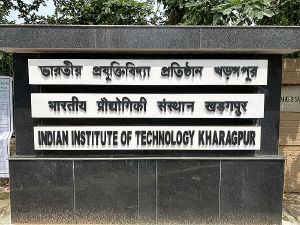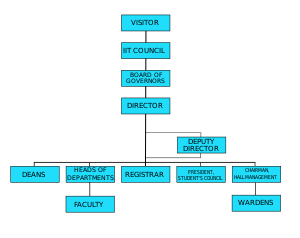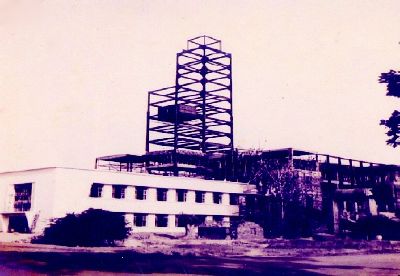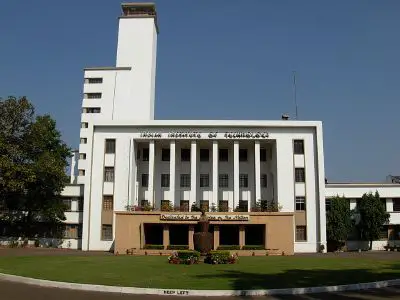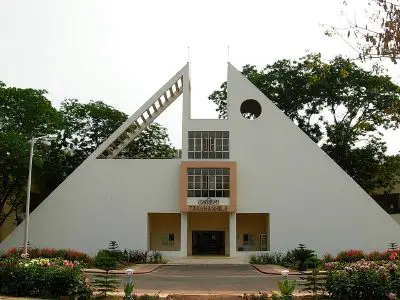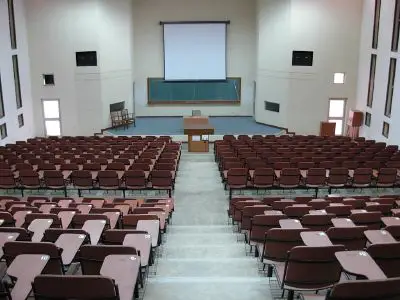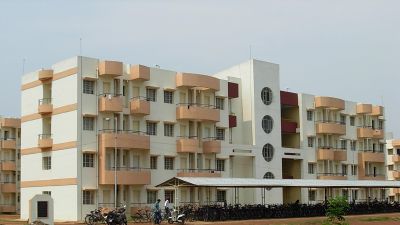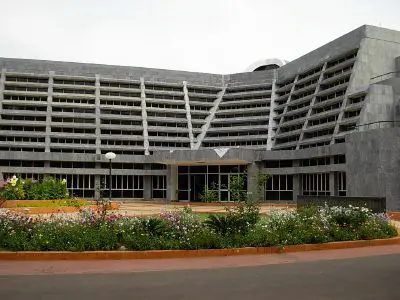Indian Institute of Technology Kharagpur
|
| |
| Motto | यà¥à¤à¤ à¤à¤°à¥à¤®à¤¸à¥ à¤à¥à¤¶à¤²à¤®à¥ (Yoga Karmasu KaushÄlam) |
|---|---|
| Established | 1951 |
| Type | Education and Research Institution |
| Location | Kharagpur, West Bengal, India |
| Campus | 2,100 acres (8.5 km²) |
The Indian Institute of Technology Kharagpur (DevanÄgarÄ«: ) (commonly known as IIT Kharagpur or IIT KGP) exists as an autonomous engineering and technology-oriented institute of higher education established by the Government of India in 1950. The first of the seven IITs established, the Government of India officially recognized it as an Institute of National Importance. Regarded as one of the best engineering institutions in India, IIT Kharagpur has ranked among the top engineering colleges in the academic ranking of Indian colleges by various engineering education surveys like India Today and Outlook.
The Indian government established IIT Kharagpur to train scientists and engineers after India attained independence in 1947. Remarkably, ITT Kharagpur began classes in the abandoned Hijli Detention Camp used by the British to imprison Indian independence movement activists. In 1952, the foundation stone for the new building was laid in a dedication ceremony attended by the Prime Minister of the Republic of India, Jawaharlal Nehru. On September 15, 1956, the Parliament of India passed the Indian Institute of Technology (Kharagpur) Act declaring it an Institute of National Importance. The mission of ITT Kharagpur has been fittingly symbolized by the original Hijli Detention Camp building: India will rise from a history of oppression into a new nation through education.
| This article contains Indic text. Without proper rendering support, you may see question marks or boxes, misplaced vowels or missing conjuncts instead of Indic text. |
ITT Kharagpur shares its organizational structure and undergraduate admission process with sister IITs. The students and alumni of IIT Kharagpur informally go by the name KGPians. Among all IITs, IIT Kharagpur has the largest campus (2,100Â acres), the most departments, and the highest student enrollment. IIT Kharagpur has particularly earned fame for its festivals: Illumination and Rangoli, Spring Fest, and Kshitij.
History
With the help of B. C. Roy (then Chief Minister of West Bengal), Indian educators Humayun Kabir and Jogendra Singh formed a committee in 1946 to consider the creation of Higher Technical Institutions for post-war industrial development of India. The creation of a 22-member committee headed by Nalini Ranjan Sarkar followed. In its interim report, the Sarkar Committee recommended the establishment of Higher Technical Institutions in various parts of the country along the lines of the Massachusetts Institute of Technology, with affiliated secondary institutions. The report urged that work should start with the speedy establishment of major institutions in the four quarters of the country with the ones in the East and the West set up immediately.
On the grounds that West Bengal had the highest concentration of industries at the time, B. C. Roy persuaded Jawaharlal Nehru (India's first Prime Minister) to establish the first institute in West Bengal. The first Indian Institute of Technology, established in May 1950 as the "Eastern Higher Technical Institute," initially located in Esplanade East, Calcutta. In September 1950 it shifted to its permanent campus at Hijli, Kharagpur located 120Â kilometres southwest of Kolkata. When the first session started in August 1951, the college had 224 students and 42 teachers in ten departments of the institute. The class rooms, laboratories and the administrative office housed in the historic building of the Hijli Detention Camp (now known as Shaheed Bhawan), where political revolutionaries had been imprisoned and executed during the British rule. The office building had served as the headquarters of the Bomber Command of the U.S. 20th Air Force during World War II.
The college adopted the name "Indian Institute of Technology" before the formal inauguration of the institute on August 18, 1951 by Maulana Abul Kalam Azad. The Shaheed Bhawan converted to a museum in 1990.[1] The Srinivasa Ramanujan Complex incorporated as another academic complex of the institute with Takshashila starting operation in 2002 and Vikramshila in 2003.
Administration
IIT Kharagpur shares a common Visitor (a position held by the President of India) and the IIT Council with other IITs. Otherwise, IIT Kharagpur has a distinct organizational structure from that of the other IITs. The IIT Council presides over the Board of Governors of IIT Kharagpur, and has thirteen members that include representatives of the states of West Bengal, Bihar, Jharkhand and Orissa, in addition to other members appointed by the IIT Council and the institute's senate. The institute's director, the chief academic and executive officer of the IIT, serves under the Board of Governors, extensively aided by the deputy director.[2] The deans, heads of departments, registrar, president of the students' council, and chairman of the hall management committee come under the director and the deputy director. The registrar serves as the chief administrative officer and oversees day-to-day operations, acting as custodian of records, funds, and other properties of the institute.[2] The faculty (full-time professors as well as those of associate and assistant status) come under the charge of the heads of departments (HOD). The chairman of the hall management committee in the organization presides over the wardens of hostels.[3]
The senate decides the IIT Kharagpur academic policies. It consists of all professors of the institute, and administrative and student representatives. The senate controls and approves the curriculum, courses, examinations and results, and appoints committees to look into specific academic matters. The senate periodically reviews the teaching, training and research activities of the institute to maintain educational standards. The director of IIT Kharagpur presides as the ex officio chairman of the senate.
IIT Kharagpur follows the credit-based system of performance evaluation, with proportional weighting of courses based on their importance. The total marks (usually out of 100) form the basis of grades, with a grade value (out of 10) assigned to a range of marks. For each semester, the students receive grades by taking a weighted average from all the courses with their respective credit points. Administration evaluates each semester independently with a cumulative grade point average (CGPA) reflecting the average performance across semesters. English serves as the medium of instruction.
Campus
IIT Kharagpur, located 120Â kilometers (75Â miles) west of Kolkata, sits five kilometers away from Kharagpur's railway station. A group of engineers and architects under the guidance of Werner M. Moser, a Swiss architect, planned the layout of the present campus and the design of the buildings. The campus has a total of 55Â kilometers (34Â miles) of roadways.
The 18 student hostels sit on either side of Scholars Avenue, which extends from the institute gate to the B. C. Roy Technology Hospital. The three earliest hallsâPatel, Azad, and Nehruâtogether constitute the PAN loop or Old Campus, located just next to Scholar's Avenue. Seven hostels house undergraduate male students and one for undergraduate female students. Another hostel for women has quite recently been constructed. In addition, a few post-graduate students' hostels, including two for women and a separate hostel for scholars from the armed forces, provide housing. The Science and Technology Entrepreneurs' Park (STEP) offers infrastructure facilities to alumni who want to become entrepreneurs but lack infrastructure to start their own corporation.
In addition to the main campus at Kharagpur, the institute has an extension center at Kolkata to provide venues for continuing education programs, distance learning courses, and guest house accommodation.
Academic buildings
IIT Kharagpur has 19 academic departments, eight multi-disciplinary centers/schools, and 13 schools of excellence in addition to laboratories and central research facilities. Apart from the main building in the central academic complex, the Srinivasa Ramanujan Complex also has common academic facilities. In the S. R. Complex, the Takshashila building houses the G. S. Sanyal School of Telecommunication, the School of Information Technology and the Computer and Informatics Centre; and has facilities for conducting lecture classes as well. Vikramshila, another academic building in the S. R. Complex, has four lecture halls, several seminar rooms, and Kalidas Auditorium, which has a seating capacity of 850.
The main building houses most of the administrative offices of the institute. It has numerous lecture halls, and two big auditoriums on either side. The tower of the main building has a steel tank with 10,000 imperial gallons of water capacity for emergency supply needs. The Netaji Auditorium in the main building is used for official functions and events, and doubles as a cinema theater on weekend nights, showing movies to the IIT community at subsidized rates.
IIT Kharagpur's first library had been located in a small room of the institute's Old Building (Shaheed Bhawan). At the time of its opening in 1951, the library had a collection of 2500 books. Now located in the main building of the institute, the Central Library has one of the largest technical library collections in Asia. The library has six halls and a section exclusively for SC and ST students. The library's collection consists of books, reports, conference proceedings, back volumes of periodicals, standards, theses, micro-forms, CD-ROMs, floppies, and audio-visual material. The library has an automated transaction service and an Online Public Access Catalog (OPAC) online search capacity. The Electronic Library section has a collection of databases, video lectures and miscellaneous other resources.
The Nehru Museum of Science and Technology has over a hundred indoor exhibits that include technical models collected from various institutions across India. The park outside the museum contains 14 open-air demonstrations and outdoor exhibits, including a hunter plane and a steam engine. The museum also has an archive room, showcasing documents relating to the history of the institute and West Midnapore district. The Rural Museum, located in the Rural Development Centre of the institute, has a collection of exhibits in local culture.
Civic amenities

The institute campus has six guest houses, a civic hospital, four nationalized banks, four schools, a railway reservation counter and a police station within its limits. The campus has its own water pumping station, electrical sub-station, telephone exchange, a market, six restaurants, and a garbage disposal section for the daily needs of the residents.[1] The institute draws its supply of water from wells near the Kosai river (located 112Â kilometres away from institute) by harnessing sub-surface water. Three deep wells near the institute supplement the supply from the river. A 16-inch (410Â mm) pipeline supplies water to 12 tanks in the campus with a total capacity of 2,800,000Â liters (615,000 imperial gallons).
IIT Kharagpur sits just outside the town of Kharagpur, in the Hijli village. The civic amenities provided to the campus of IIT Kharagpur make it nearly self-sufficient with regards to the basic needs of the residents. As Kharagpur, a small town, has limited direct interaction between the campus community and the town. Also little opportunity for the employment of family members of the faculty exists. IIT Kharagpur provides much of its benefits to the local community through the Rural Development Centre (RDC) located in the campus. Established in 1975, the RDC helps the local community by developing customized technologies.[4] The RDC also co-ordinates the National Service Scheme (NSS) programs in IIT Kharagpur, with the members of NSS taking part in weekly community service activities such as sanitation, road construction, teaching and building educational models.
In 2005, IIT Kharagpur constructed of a boundary wall for the security of the campus, imposing restrictions to entry upon completion. The local community opposed that restriction of their access to amenities provided by the institute. The local community also opposed the construction of a flyover from the railway station to the campus, as it would lead to substantial losses of opportunity for the shops along the roads.[5] The construction of the 1052.69 m long flyover received approval from the Indian Railways and West Bengal state government, formally called Hijli Road overbridge, and constructed at a cost of Rs. 237 million ($ 5.3 million).[6]
Admissions and academics
Students gain admission to most undergraduate and postgraduate courses in IIT Kharagpur through written entrance examinations. A personal interview plays a key role in admission to M.S. and Ph.D. programs, though candidates have to take written tests as well.
Admission to undergraduate programs in all IITs requires taking the Indian Institute of Technology Joint Entrance Examination, popularly known as IIT-JEE. Candidates who qualify for admission through IIT-JEE can apply for admission in B.Tech. (Bachelor of Technology), Dual Degree (Integrated Bachelor of Technology and Master of Technology) and integrated M.Sc. (Master of Sciences) courses at IIT Kharagpur. Students gain admissions to postgraduate programs (M.Tech.) primarily through the Graduate Aptitude Test in Engineering (GATE). Other prominent postgraduate entrance exams include Joint Admission to M.Sc. (JAM) for M.Sc., and Joint Management Entrance Test (JMET) for management studies.
IIT Kharagpur belongs to LAOTSE, an international network of universities in Europe and Asia exchanging students and senior scholars. The institute has frequently been ranked as India's best engineering institute by India Today.
Undergraduate education
IIT Kharagpur offers a number of degrees as part of its undergraduate programs. They include Bachelor of Technology (B.Tech.), Bachelor of Architecture (B.Arch.) and the Bachelor of Science (B.Sc.; integrated with corresponding masters degree, M.Sc.). The B.Tech. degree, the most common undergraduate degree in IIT Kharagpur in terms of student enrollment, has a four-year program with eight semesters. The first year of the B.Tech. curriculum has common courses from various departments. At the end of the first year, meritorious students on the basis of their performance in the first two semesters have an option to change departments.
From the second year onward, the students take up courses offered exclusively in their respective departments called depth courses. In addition to those, the students have to take a number of inter-disciplinary courses known as breadth courses. Separate courses from the humanities and social sciences (HSS) department, and management and information technology fill out the requirements. At the end of the third year, the B.Tech. and Dual Degree students undertake mandatory industrial training for a minimum period of eight working weeks as part of the undergraduate curriculum. In the final year of their studies, most of the students receive job offers in industries and other organizations through the Training and Placement (T&P) section of the institute. Some students opt out of that opportunity in favor of higher studies, or to take up jobs by applying to recruiting organizations directly. In addition to the major degree as part of the undergraduate education, students can take up additional subjects from other departments, and by demonstrating knowledge of a discipline based on performance parameters and course objectives set by the department, earn a minor in that department.
Postgraduate and doctoral education
IIT Kharagpur offers a number of postgraduate programs including Master of Technology (M.Tech.), Master of Business Administration (MBA), and Master of Sciences (M.Sc.). Some specialized graduate programs offered by IIT Kharagpur include Postgraduate Diploma in Information Technology (PGDIT), Master in Medical Science and Technology (MMST), Master of City Planning (MCP), Postgraduate Diploma in Intellectual Property Law (PGDIPL), and Postgraduate Diploma in Maritime Operation & Management (PGDMOM). IIT Kharagpur offers the Doctor of Philosophy degree (Ph.D.) as part of its doctoral education program. Professors give doctoral scholars a topic of academic focus, or sometimes work on the consultancy projects sponsored by various industries. The duration of the program usually last an unspecified time depending on the specific discipline. Ph.D. scholars have to submit a dissertation as well as conduct an oral defense of their thesis. Scholars receive teaching assistantships (TA) and research assistantships (RA) based on their academic record. IIT Kharagpur offers an M.S. (by research) program; the M.Tech. and M.S. being similar to the US universities' non-thesis (course-based) and thesis (research-based) master program respectively.
IIT Kharagpur (along with other IITs) offers Dual Degree programs that integrate undergraduate and postgraduate studies in selected pairs of branches and specializations. Most of the Dual Degree programs involve specialization in the major field of education of the student. For a dual degree involving an MBA from Vinod Gupta School of Management, students across all engineering streams compete for selection through an aptitude test. The Dual Degree program spans a period of five years as against six years in conventional B.Tech. (four years) followed by an M.Tech. or MBA (two years). IIT Kharagpur has a management school (Vinod Gupta School of Management) and a law school (Rajiv Gandhi School of Intellectual Property Law) on its premises.
Continuing education
IIT Kharagpur offers the Continuing Education Programme (CEP) for qualified engineers and scientists to learn new technologies and developments in their academic disciplines. As part of CEP, the institute offers formal degree programs (M.Tech. and Ph.D.) and an Early Faculty Induction Programme (EFIP) under the Quality Improvement Programme (QIP), short-term courses supported by the All India Council for Technical Education, self-financed short-term courses supported by course fees, and certificate courses conducted as distance education. In addition to conducting educational courses, the CEP develops model curricula for engineering education. As of 2006, the CEP has facilitated publication of 103 course curriculum books. The CEP administers SIMAP (Small Industries Management Assistant Programme) and STUP (Skill-cum-Technology Upgradation Programme) on behalf of IIT Kharagpur; the institute being a corpus institute of SIDBI (Small Industries Development Bank of India).
Sponsored research
The institute has received numerous grants for research. It has filed over 100 patents, not including patents obtained by individual professors or students. Major sponsors for research include the Indian National Science Academy, Ministry of Human Resource and Development, Defence Research and Development Organisation, Microsoft Corporation, Department of Science and Technology, and Indian Space Research Organisation. IIT Kharagpur has had a separate cell known as the SRIC (Sponsored Research and Industrial Consultancy) cell since 1982. It handles sponsored research projects and industrial consultancy assignments, and has the infrastructure to simultaneously administer 600 R&D projects.
Student life and culture
IIT Kharagpur provides on-campus residential facilities to its students, research scholars and faculty. The students live in hostels (referred to as halls) throughout their stay in the IIT. Undergraduate students must choose between National Cadet Corps (NCC), National Service Scheme (NSS) and National Sports Organisation (NSO) for their first two years of study. IIT Kharagpur has common sports grounds for cricket, football, hockey, volleyball, lawn tennis, badminton, and athletics; and swimming pools for aquatic events. Most of the hostels have their own sports grounds.
The students of IIT Kharagpur compete among themselves in various events held under the purview of open-IIT and inter-hall events, and the results of the latter contribute to the overall tally of points that determine the winner of General Championship. The four broad categories with General Championships include Sports, Social & cultural activities, Technology, and Hall affairs. The women's hostel together participate as a single team in all events with the exception of sports, where women's team do not participate at inter-hall level. IIT Kharagpur participates in the Inter-IIT Sports Meet, held annually in one of the IITs by policy of rotation.
The students of IIT Kharagpur choose their representatives by elections held under the purview of the Technology Students' Gymkhana. The Vice-President of the Gymkhana stands as the highest-ranking student representative chosen by the elections and represents the students in the senate. All halls nominate two representatives for the senate. The Gymkhana publishes an annual magazine called Alankar. An independent student body publishes a fortnightly newsletter called The Scholar's Avenue, named after the avenue common to the student halls. Individual halls organize "Hall day"âan annual event that involves lighting and decoration of the organizing hall, with a social gathering of students from all hallsâduring the month of March. The halls use the event to popularize their candidates for student body elections.
Students who violate the code of conduct of the institute have to defend themselves in front of the Hall Disciplinary Committee (HDC), which investigates the case and prescribes punishment if necessary. Students may appeal against the punishment to the Appellate-cum-Liaison Committee known as Inter Hall Disciplinary Committee (IHDC). The IHDC submits its recommendations to the Senate, which finalizes the punishment. Extreme cases of indiscipline go directly to the IHDC. The IHDC has been authorized to give punishments to students for acts of indiscretion committed anywhere in India. IIT Kharagpur has strict provisions dealing with physical and mental harassment of junior students (ragging). First year undergraduate male students have separate halls off-limits to senior students. Students found harassing their juniors receive suspension from the institute, without going through the Disciplinary Committee.
Festivals
IIT Kharagpur organizes a techno-management festival known as Kshitij, the biggest techno-management festival of Asia with a total budget of around 50 lakh. An annual techno-management festival organized in January or February, it receives participation from other colleges as well. Events include technical workshops, seminars, and competitions. Robotix, the annual robotics competition held by IIT Kharagpur, takes place during Kshitij. The cultural festival, Spring Fest takes place in January. Spring Fest includes numerous cultural competitions in addition to stage shows (known as Star-nights) by noted singers and performers. The Star-nights make up the main attraction of Spring Fest; often more than 10,000 people pack into the Tagore Open Air Theatre, built with a capacity of 3,000 people. The event attracts participation from colleges across India.[1]
Illumination festival, popularly known as Illu, constitutes a festival unique to IIT Kharagpur inspired from the day of Diwali (the festival of lights). Usually held on the day of Diwali itself, the festival pits student halls against each other. As part of the Illumination festival, all halls build vertical panels of bamboo (called Chatais) with thousands of lamps (diyas) mounted forming outlines of people or things; illustrating an event, or a place of importance. The chatais may reach a height of 6Â meter (20Â feet), with nearly 20,000 lighted lamps. The lamps on the chatais light up with all other light sources switched off, to showcase the art-panels made by the flickering lamps. On the same day as Illumination, the Rangoli Competition takes place as an inter-hall event. Rangolis of exquisite detail and shadingâmeasuring around 3.5Â m (12Â ft) long by 3.5Â m wideâconstructed using colored powders, crushed bangles, and pebbles. Interplay of light and shadow and ambient music interplay.
Alumni
The alumni of IIT Kharagpur have achieved prominence in various fields. Sushantha Kumar Bhattacharyya received the CBE, a knighthood,[7] and Padma Bhushan; and V. C. Kulandaiswamy received Padma Shri award and Padma Bhushan.[8] Mani Lal Bhaumik invented the excimer laser. Srikumar Banerjee became the Director of the Bhabha Atomic Research Centre and Kirit Parikh was the founder director of Indira Gandhi Institute of Development Research (IGIDR) and a member of Union Planning Commission of India. In the corporate world, Suhas Patil founded Cirrus Logic, Arjun Malhotra co-founded HCL Technologies, Vinod Gupta founded InfoUSA, Ajit Jain became president of Berkshire Hathaway's Reinsurance Group, and Arun Sarin became the CEO of Vodafone. R. Gopalakrishnan serves as the Director of Tata Motors and Tata Power. Prith Banerjee has been appointed as the worldwide director of HP Labs, the research wing of Hewlett-Packard.
The Vinod Gupta School of Management and Rajiv Gandhi School of Intellectual Property Law had been established with donated funds from Vinod Gupta. Other centers built by funding from alumni include the G.S. Sanyal School of Telecommunication and VLSI-CAD laboratory. The IIT Foundation, started by Vinod Gupta in 1992, constitutes the alumni association of the institute having chapters in many cities in India and abroad. IIT Kharagpur has a dean for alumni affairs to manage liaisons with alumni. The institute organizes an annual alumni meet in January.
Notes
- â 1.0 1.1 1.2 Suhrid Sankar Chattopadhyay, Kharagpur's legend. Frontline, April 27, 2002. Retrieved November 11, 2021.
- â 2.0 2.1 Public Information Officer, Right to Information: Powers and duties of Officers and Employees. Indian Institute of Technology Kharagpur. Retrieved November 11, 2021.
- â Public Information Officer, Right to Information: 2.7 Organizational Structure. Indian Institute of Technology Kharagpur. Retrieved November 11, 2021.
- â Center for Rural Development and Innovative Sustainable Technology. IIT Kharagpur. Retrieved November 11, 2021.
- â Saibal Sen, Beyond the IIT wall, a world apart. The Times of India, April 15, 2006. Retrieved November 11, 2021.
- â Chandreyee Chatterjee, IIT gets its flyover, finally. The Telegraph - Calcutta, April 13, 2007. Retrieved November 11, 2021.
- â Paul Hayter, Minutes and Order Paper - Minutes of Proceedings. House of Lords, UK, June 9, 2004. Retrieved November 11, 2021.
- â Special Correspondent, Padma Vibhushan for Rangarajan, Amonkar, Sorabjee. The Hindu, March 23, 2002. Retrieved November 11, 2021.
ReferencesISBN links support NWE through referral fees
- Chattopadhyay, Suhrid Sankar. Focus: IIT-Kharagpur "Enabling industrial progress" Frontline 19(18) (August 31 - September 13, 2002). Retrieved October 4, 2011.
- Chattopadhyay, Suhrid Sankar. Focus: IIT-Kharagpur "A committed player" Frontline 19(18) (August 31 - September 13, 2002). Retrieved October 4, 2011.
- Deb, Sandipan. The IITians: The Story of a Remarkable Indian Institution and How Its Alumni Are Reshaping the World. New Delhi: Viking, 2004. ISBN 0670049867
- Indian Institute of Technology (Kharagpur, India). 1961. A decennial report, 1950-60. OCLC 1504393
External links
All links retrieved November 28, 2024.
Credits
New World Encyclopedia writers and editors rewrote and completed the Wikipedia article in accordance with New World Encyclopedia standards. This article abides by terms of the Creative Commons CC-by-sa 3.0 License (CC-by-sa), which may be used and disseminated with proper attribution. Credit is due under the terms of this license that can reference both the New World Encyclopedia contributors and the selfless volunteer contributors of the Wikimedia Foundation. To cite this article click here for a list of acceptable citing formats.The history of earlier contributions by wikipedians is accessible to researchers here:
The history of this article since it was imported to New World Encyclopedia:
Note: Some restrictions may apply to use of individual images which are separately licensed.
